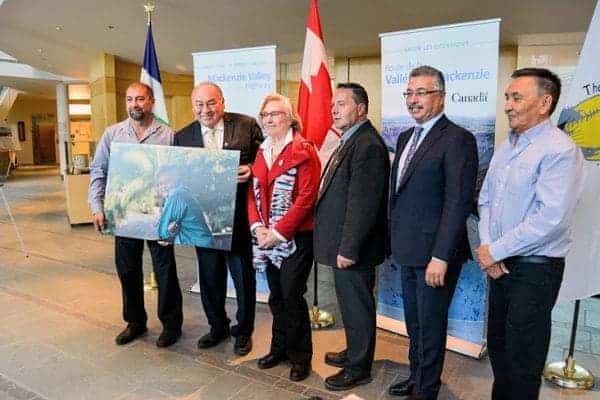The Mackenzie Valley Highway project will see an investment of $102.5 million from the federal government and another $37.5 million from the GNWT, for a total investment of $140 million.
“It marks a major milestone towards a long promised dream of a highway through the Northwest Territories,” said Premier Bob McLeod.

The funding will support the 2021 construction of a bridge over the Great Bear River and a 15-kilometre all-weather road from Wrigley to Mount Gaudet, connecting Wrigley to the Dempster Highway and generating an estimated 400 jobs. The construction will take two summer seasons.
It's part of a larger plan to build a highway to the Beaufort Sea, which is predicted to cost a total of $700-million.
McLeod paid homage to founding Inuvik Dene Chief and columnist Cece Hodgson McAuley.
She passed away at 95 years and was a “tireless advocate for connecting the people of the North ... through the realization of an all-weather road project,” he said, bringing out a photograph of McAuley.
McAuley was born in 1922 at Canyon Creek between Norman Wells and Tulita. Her son, Todd McAuley was present during the announcement.
“She's fought for the highway for so long. It's an honour to have people recognize that at the end of the day. She was a tireless advocate of the highway and invested lots of her personal time and money into fighting and lobbying for it. It was nice to see everybody talk about her with smiles on their faces,” said McAuley in an interview with News/North.
The highway investment is “proof that the dreams of people like Cece Hodgson McAuley are being respected and can be achieved,” said McLeod.
“These are the projects that allow existing industries to plan for the future of the Northwest Territories and allow new sectors of our economy like tourism to have a real chance to contribute to the wealth and well-being of our residents,” said McLeod.
The investment will lower the costs of developing extractive industry and tap into oil reserves in the Sahtu, said McLeod.
In response to a question about what the road could do for petroleum development, Premier Bob McLeod responded that the GNWT signed on to pan-Canadian Framework on Climate change and established three priorities for reducing greenhouse gas emissions, including converting to renewable alternatives.
The investment is important for residents and opening doors for resource development, said Sahtu MLA Daniel McNeely in an interview with News/North.
“This is a historic day for the Sahtu people. A project that has been long-talked about since the John Diefenbaker days,” said McNeely.
“We have a lot of resources to contribute back to the NWT GDP,” he said, motioning to tourism, oil and gas and mineral potential,” he said.
A year-round highway will improve quality of living for residents by improving access to medical services, cutting the cost of supplies including fuel and food and improving connections between communities, said Charles McNeely, Sahtu Secretariat chair.
“The highway will open up vast reserves of petroleum reserves, world class in scale,” said McNeely, adding that the highway will generate economic benefits to Northerners.
“SSI has long supported the GNWT in its efforts to develop the much needed Mackenzie Valley Highway,” said McNeely.
It will also improve opportunities for youth and families to connect more easily, he said.
The highway will become a “key driver of economic activity” in the Sahtu and reliably connect the communities and reduce the cost of living, said Carolyn Bennett, minister of Crown-Indigenous Relations and Northern Affairs (CIRNAC).
The Sahtu sits on a oil patch, though reserves of oil in the Beaufort were recently subjected to a five year moratorium in December 2016.
The moratorium will be subject to a review the same year the highway is set to start construction.
“It's very important to have investments to combat climate change and transportation and the importance to have access for communities. It's very important for the economy, but also for ... quality of life (and) for the hopes of the youth,” said Bennett in French.
It will also improve the movement of goods to market, ensuring access to global markets, she said.
As for further investments in the territory, Bennett said the federal government must develop a strategy on long-term funding initiatives.
The federal government is committed to making investments that address “bottlenecks” and “vulnerabilities” for trade corridors to the global marketplace, said Bennett.
This initial investment would insulate the winter road from the effects of climate change and shorter cold seasons and will extend the number of operating days by two to four weeks.
The funding is likely to come in increments, as the GNWT works to finalize plans for a remaining 321-kilometre highway between Wrigley and Norman Wells.
The project has yet to go through an environmental assessment process, though the GNWT does not anticipate any setbacks, said transportation minister Wally Schuman during a press conference.
“Some of that regulatory stuff is going to take a bit of time, but it's still a positive day for us,” said Schuman.
The winter road will address the North's “huge infrastructure deficit,” said MP Michael McLeod. “We're hearing it from municipalities. We're hearing it from the government of the Northwest Territories. We're hearing it from Indigenous governments. We're hearing it from the Chamber of Mines.”